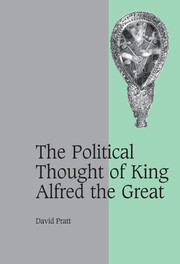Book contents
- Frontmatter
- Contents
- Acknowledgements
- List of abbreviations
- Note on citations
- Chapter 1 INTRODUCTION
- Part I The West Saxon Political Order
- Part II Alfredian Discourse and its Efficacy
- Chapter 7 THE FIELD OF ALFREDIAN KNOWLEDGE
- Chapter 8 THE CONSTRUCTION OF ALFREDIAN DISCOURSE
- Chapter 9 ALFREDIAN TECHNOLOGY: BOOKS AND ÆDIFICIA
- Chapter 10 THE HIERDEBOC AS A TREATISE OF POWER
- Chapter 11 THE DOMBOC AS A REORIENTATION OF ROYAL LAW
- Chapter 12 TRIBULATION AND TRIUMPH IN THE FIRST FIFTY PSALMS
- Chapter 13 THE SEARCH FOR A SATISFACTORY CONSOLATION
- Chapter 14 SEEING GOD AS HE IS
- Chapter 15 CONCLUSION
- Appendix: West Frankish deployment of Solomon's dream
- Bibliography
- Index of manuscripts
- General index
- Cambridge Studies in Medieval Life and Thought Fourth Series
Chapter 15 - CONCLUSION
Published online by Cambridge University Press: 06 July 2009
- Frontmatter
- Contents
- Acknowledgements
- List of abbreviations
- Note on citations
- Chapter 1 INTRODUCTION
- Part I The West Saxon Political Order
- Part II Alfredian Discourse and its Efficacy
- Chapter 7 THE FIELD OF ALFREDIAN KNOWLEDGE
- Chapter 8 THE CONSTRUCTION OF ALFREDIAN DISCOURSE
- Chapter 9 ALFREDIAN TECHNOLOGY: BOOKS AND ÆDIFICIA
- Chapter 10 THE HIERDEBOC AS A TREATISE OF POWER
- Chapter 11 THE DOMBOC AS A REORIENTATION OF ROYAL LAW
- Chapter 12 TRIBULATION AND TRIUMPH IN THE FIRST FIFTY PSALMS
- Chapter 13 THE SEARCH FOR A SATISFACTORY CONSOLATION
- Chapter 14 SEEING GOD AS HE IS
- Chapter 15 CONCLUSION
- Appendix: West Frankish deployment of Solomon's dream
- Bibliography
- Index of manuscripts
- General index
- Cambridge Studies in Medieval Life and Thought Fourth Series
Summary
Placed in context, Alfred's texts emerge as highly effective props of kingship, intensively vested with his agency and power. Their force drew in all directions on Alfred's own position at the heart of his household; the roots of his learning can be traced to this immediate, West Saxon environment. As ubiquitous lord his role epitomized the distinctive strengths of West Saxon kingship, consolidated under this single dynasty by his father and grandfather. Its operation tapped still deeper structures, in the West Saxon shire system, with ealdormen under royal authority, and the position of West Saxon thegns, as landed royal agents. Its basis in the ninth century was an expanding array of royal monopolies, conspicuously shared with thegnly beneficiaries. Many exploited forms of income, in tolls, renders and fines, enhanced by the acquisition of south-eastern mints; all complemented effective jurisdiction in the loaning and ‘booking’ of land. Such processes were critically aided by abrupt changes in the Southumbrian church, effecting the abandonment of synods and synodal culture towards structures similarly dominated by West Saxon lordship. Disputes over bookland received royal settlement, in a single hierarchy of justice. Royal mechanisms brought bishops as effective local agents, intensified by the use of royal priests as episcopal personnel.
All these structures accorded centrality to the royal household, as a constant arena of power. Patterns of attendance accentuated this status, enabling lengthy and intimate royal contact with all thegns of the king.
- Type
- Chapter
- Information
- The Political Thought of King Alfred the Great , pp. 338 - 350Publisher: Cambridge University PressPrint publication year: 2007

